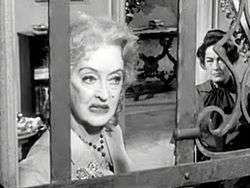Psycho-biddy
Psycho-biddy (Also known as Grande Dame Guignol, hagsploitation and hag horror)[1] is a colloquial term for a film subgenre which combines elements of the horror thriller and the Woman's Film which conventionally features a formerly-glamorous older woman who has become mentally unbalanced and terrorizes those around her. The genre was inaugurated in 1962 with the film What Ever Happened to Baby Jane? and lasted through the mid-1970s. Renata Adler, in her New York Times review for the 1968 film The Anniversary, referred to the genre as "the Terrifying Older Actress Filicidal Mummy genre."[2]

Definition, themes and influences
The subgenre features a mentally unstable, dangerous, or insane woman of advanced years with a somewhat glamorous past, living a life of relative wealth. In some cases, the woman may be in jeopardy of some sort, with another party attempting to drive her to mental instability. Often (but not always), there are two older women pitted against one another in a life-or-death struggle, usually the result of bitter hatreds, jealousies, or rivalries that have percolated over the course of, not years, but decades. These combatants are often blood-relatives. The character is often brought to life in an over-the-top, grotesque fashion, emphasizing the unglamorous process of aging and eventual death. Characters are often seen pining for lost youth and glory, trapped by their idealized memories of their childhood, or younger days, and the trauma of a past episode that haunts them.
This subgenre includes elements of many other genres, including gothic, Grand Guignol, black comedy, psychodrama, melodrama, and even the musical.
History
The genre began in 1962 with What Ever Happened to Baby Jane? directed by Robert Aldrich. What Ever Happened to Baby Jane? bolstered the flagging careers of its stars, Bette Davis as Baby Jane Hudson and Joan Crawford as Blanche Hudson. The 1950 Billy Wilder classic Sunset Boulevard shares thematic similarities (their respective central characters both psychotically deranged formerly-glamorous older women) with What Ever Happened to Baby Jane? and can be seen as a precursor to the genre.[1]
Baby Jane set many trends and more-or-less defined the genre: the theatrical performance, the trappings of wealth and Hollywood, and psychologically complex melodrama. Jane goes quite insane over the course of the movie, torturing her crippled sister and venting long-pent up hostilities and guilt. At the end of the film, Blanche makes a confession which details and admits of her own complicity in the whole affair. The film was quite successful, garnering Academy Award nominations, including one for Davis.
Crawford then starred in director and producer William Castle's Strait-Jacket (1964) as Lucy Harbin, the accused axe-murderer of her husband and his mistress, who is released from the asylum for the criminally insane after 20 years to be reunited with her beloved daughter and other friends. When a new string of axe-murders begins, it is naturally assumed that it is Lucy committing them.
The two actresses were reunited again with director Robert Aldrich for a Baby Jane "follow-up", Hush...Hush, Sweet Charlotte (1964), despite a hyped, somewhat exaggerated feud. But genuine mutual dislike between the two actresses led to Crawford bowing out. She was replaced by Olivia de Havilland, who knew how to get along with Davis. Veteran actresses Agnes Moorehead and Mary Astor also appeared in the film.
In Charlotte, Davis was not only the one going insane, but was the "officially" sympathetic character, who is gaslit by her cousin (De Havilland) and her doctor, the cousin's lover (Joseph Cotten). In this movie, Davis' character is again haunted by guilt, though this time the ante is upped: instead of believing herself responsible for a crippling, she believes she is responsible for the murder of her lover. Charlotte is one of the most successful examples of the genre, and is noted for using Southern Gothic atmosphere.
Mad Magazine poked fun at the genre in 1966 with a movie musical satire entitled "Hack, Hack Sweet Has-Been-or Whatever Happened to Good Taste?"[3]
Examples
While the subgenre has existed over a broad time period, it is closely tied to the 1960s, and the end of the Classical Hollywood Era.[1] Thus, while there are many entries into the subgenre which exist outside of this decade (it is preceded by such films as Sunset Boulevard and The Star, and followed by Misery and Mommie Dearest), it should be primarily considered within the context of the dying studio system.
- What Ever Happened to Baby Jane? (Robert Aldrich, 1962)
- Strait-Jacket (William Castle, 1964)
- Dead Ringer (Paul Henreid, 1964)
- Lady in a Cage (Walter Grauman, 1964)
- Hush...Hush, Sweet Charlotte (Robert Aldrich, 1964)
- The Night Walker (William Castle, 1965)
- Die! Die! My Darling! (Silvio Narizzano, 1965)
- I Saw What You Did (William Castle, 1965)
- Berserk! (Jim O'Connolly, 1967)
- What Ever Happened to Aunt Alice? (Lee H. Katzin, 1969)
- What's the Matter with Helen? (Curtis Harrington, 1971)
- Whoever Slew Auntie Roo? (Curtis Harrington, 1971)[1]
References
- Shelley, Peter (September 15, 2009). Grande Dame Guignol Cinema: A History of Hag Horror from "Baby Jane" to "Mother". Jefferson, North Carolina and London: McFarland and Company, Inc. ISBN 978-0786445691.
- New York Times review
- "Hack, Hack Sweet Has-Been -or Whatever Happened to Good Taste?" Written by Mort Drucker, Illustrated by Larry Siegel. MAD Magazine, Issue No. 100, January 1966.
https://www.rue-morgue.com/menopausal-maniacs-a-hag-horror-watchlist/